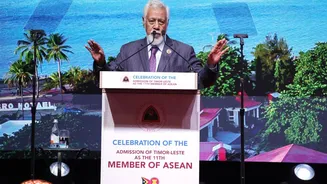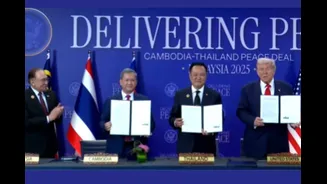A Historic Agreement
The signing of the Thailand-Cambodia peace accord represented a watershed moment in the relationship between the two Southeast Asian nations. This agreement,
coming at a time of shifting global dynamics, was a testament to the dedication of both countries to resolve long-standing disputes and forge a cooperative future. The accord's significance went beyond a simple cessation of hostilities; it was a firm step toward lasting peace, designed to boost economic development, and advance regional stability. This agreement was particularly important given the complex history between Thailand and Cambodia, which had, at times, led to tensions and conflicts. The commitment to peace, displayed through this agreement, showcased both nations' willingness to prioritize diplomacy and partnership over past grievances, pointing the way toward a more united Southeast Asia.
Strengthening Regional Ties
The Thailand-Cambodia peace accord was pivotal in strengthening regional ties, laying the foundation for greater collaboration within the Southeast Asian community. The agreement had a significant impact on trade, tourism, and cultural exchange between the two nations, which would encourage economic growth. Further, the accord would allow the countries to align on issues like border management, environmental conservation, and counter-terrorism measures. The collaboration fostered by this peace agreement also served as a model for other nations in the region, illustrating the value of diplomacy in resolving conflicts. The international community has largely welcomed this historic agreement, seeing it as an important step towards peace and stability. The agreement underscored the significance of peaceful coexistence and offered a platform for sustained cooperation, benefiting not only Thailand and Cambodia but also the wider Southeast Asian region.
Key Components of Accord
Several key components defined the Thailand-Cambodia peace accord, ensuring its effectiveness and longevity. The core elements included detailed provisions regarding border demarcation, resource sharing, and joint security protocols. The treaty also emphasized the development of joint initiatives in areas such as trade and tourism, and establishing channels for regular communication and dispute resolution. Moreover, the peace accord provided a framework for addressing historical grievances, which was essential to rebuilding trust and promoting reconciliation. The agreement incorporated international standards and best practices, ensuring fairness and transparency in its implementation. It was also designed to be flexible and adaptable, which allowed it to evolve with changing circumstances and challenges. A notable aspect of the accord was the creation of a joint committee to oversee its implementation. This committee was composed of representatives from both Thailand and Cambodia and would ensure that the agreement was honored and that any emerging issues were handled effectively.
Impact on Both Nations
The impact of the peace accord was felt across various sectors in both Thailand and Cambodia. In Thailand, the agreement helped create an environment of economic opportunity, by allowing for increased tourism and trade with its neighbor. The stability engendered by the accord also boosted investor confidence and encouraged foreign investment. In Cambodia, the agreement was instrumental in supporting its ongoing efforts at sustainable development and improved governance. The enhanced cooperation fostered by the accord led to better infrastructure projects, including improved roads and border crossings, promoting greater connectivity. The agreement also facilitated the exchange of cultural and educational programs, fostering mutual understanding and respect between the populations of both countries. The overarching result of the accord was an enhanced sense of security and stability, enabling both nations to focus on their respective development agendas, and fostering a shared vision for a prosperous future.
Future Prospects Unfold
Looking forward, the Thailand-Cambodia peace accord has promising implications for the future. The agreement has the potential to boost economic growth by fostering increased trade, investment, and tourism between the two nations. It has created a solid base for collaborative initiatives in fields like environmental protection, counter-terrorism, and education. Furthermore, the success of the peace accord could be a model for resolving conflicts in other parts of the world. It showed how sustained dialogue and compromise could lead to lasting peace and stability. As the implementation of the agreement continues, both Thailand and Cambodia are poised to benefit from shared progress, and a strengthened partnership. The lasting goal is to cultivate a robust and cooperative relationship, which has the potential to transform the region.















